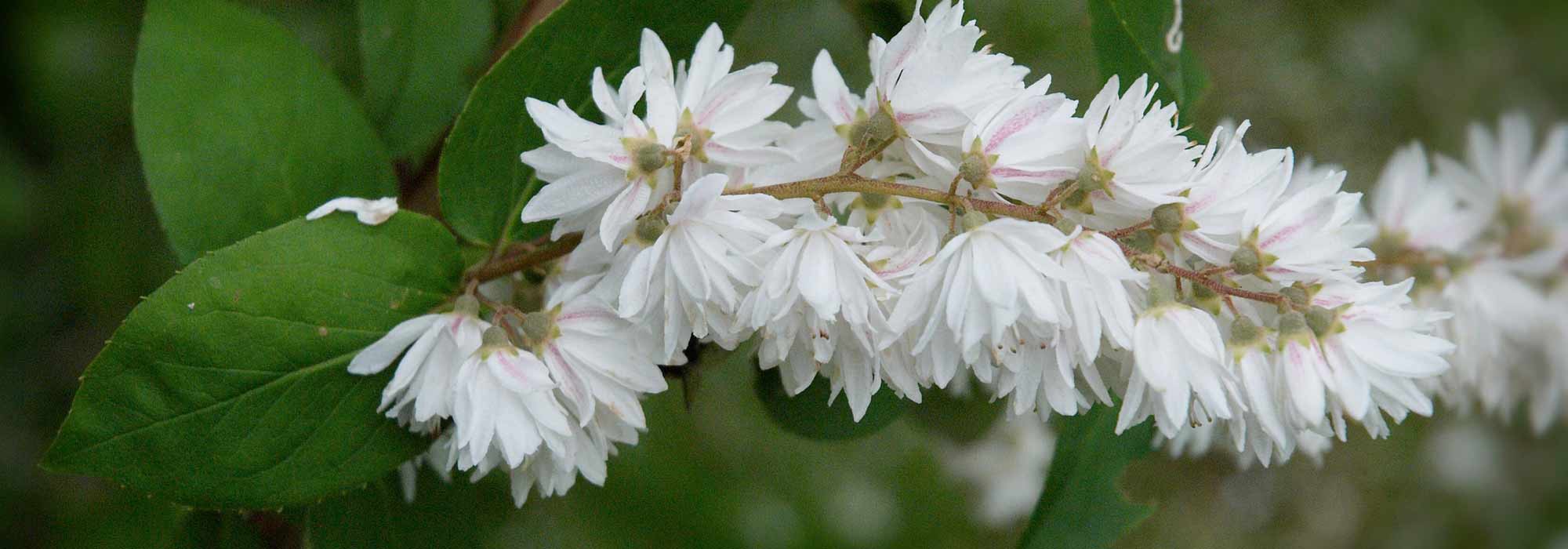
Deutzia: planting, pruning, care
Contents
Deutzia in a nutshell
- Deutzia is a bush that is easy to grow, making it ideal even for novice gardeners
- With its white or pink flowers, its spring flowering is spectacular!
- Very hardy and never sick, it thrives in any good garden soil that remains cool
- Its growth is rapid but it does not become too large, making it perfect for small gardens
- Versatile, it is a classic choice for hedges, and it is also used in borders, as a specimen, or in pots
A word from our expert
The Deutzia is a beautiful spring-flowering bush, highly valued for its endless airy flowering, compactness, and great ease of cultivation. A bit out of fashion, deutzia is one of those nearly indestructible bushes, low-maintenance, that bring much satisfaction to gardeners, even novices, with little effort.
At the end of spring, it is covered with a cloud of small white or pink flowers, like Deutzia crenata ‘Pride of Rochester’, the pink deutzia, scabra ‘Plena’, or Deutzia (x) magnifica ‘Tourbillon Rouge’.
A bush of reasonable size, Deutzia is a reliable choice, essential in all gardens, even small ones, in free hedges as well as in borders. The smaller varieties, such as Deutzia gracilis ‘Nikko’, which will not exceed 1 m in height at ripeness, can be used as a ground cover on a sunny bank or planted in a container on the terrace.
Very hardy, resistant to cold and frost, Deutzia is accommodating in all fresh soils, even mediocre, acidic or calcareous, exposed to partial shade or full sun. Although it flowers best in rich, well-drained soils.
From pruning deutzia to planting, discover through our collection of deutzias, some of which are rare and exclusive, this easy-to-grow bush, ideal for brightening up a somewhat dark area of the garden.
Description and Botany
Botanical data
- Latin name Deutzia
- Family Hydrangeaceae
- Common name Deutzia
- Flowering from May to July
- Height 0.50 to 3 m
- Exposure Sun, partial shade
- Soil type All, well-drained
- Hardiness -20°C
The Deutzia belongs to the Hydrangeaceae family (formerly Saxifragaceae), just like hydrangeas. Native to East Asia, this deciduous bush naturally grows in thickets and wooded areas of the Himalayas.
The genus Deutzia comprises around sixty species, among which the most common are Deutzia gracilis, Deutzia x magnifica, Deutzia scabra, and Deutzia purpurascens, which have given rise to numerous hybrids such as Deutzia (x) elegantissima and interesting cultivars like ‘Nikko’, one of the best cultivars of Deutzia.
Of rather rapid growth, it reaches its adult size in 5 to 7 years, without exceeding a height of 3 m at maturity, with a spread of 2 m for the larger Deutzia varieties. Some very recent hybrid varieties (Yuki) form a dome that will not exceed 60 cm in all directions and have the ability to layer spontaneously, allowing them to eventually form a large ground cover.
Deutzia forms a small upright bush, more or less compact due to its ramified vegetation. The habit is vigorous and rounded, taking on a more erect appearance if its pruning is neglected. The slender branches, more or less trailing at the tips, become arching over time.
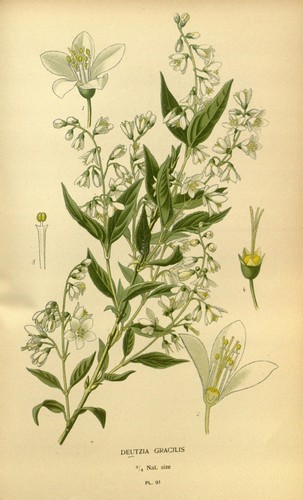
Deutzia gracilis – botanical illustration
In spring, oval or lance-shaped leaves, elongated and often slightly dentate on their margins, appear, borne by a short petiole, on long straight cane-like stems. Medium to dark green on top, 2 to 12 cm long, sometimes strongly veined, they often have a grey-green and villous underside, even rough in the case of Deutzia scabra (which means “rough” in Latin). Depending on the variety, they turn bronze and purple-violet at the end of the season.
Some, like Deutzia scabra, remain very decorative even after leaf fall with their beautiful cinnamon-brown bark that exfoliates as it matures.
Its spring flowering is a delight! At the beginning of summer, from May until July depending on the climate, this spring green foliage disappears under a avalanche of small flowers in very romantic shades. A spectacular flowering that takes on the appearance of a very delicate cloud, when it is pure white, Deutzia is also nicknamed “Spring Snow.” Of infinite delicacy, these corollas produced relentlessly come in all shades of white, pink, sometimes purple mauve or lavender blue.
Gathered in round bouquets, upright clusters, or large airy panicles 2 to 15 cm long, these small flowers with 5 petals in cup or star shapes bloom for 4 weeks. Simple or double, they are 0.50 to 3 cm wide. These delicate corollas evoke, in turn, the flower of lilac, the bell of lily of the valley, that of Kalmias, or even a cherry blossom.
Some, like ‘Tourbillon Rouge’ or ‘Plena’, are remarkable for their striated petal undersides, giving a bicolour and luminous aspect to the flowering. Depending on the varieties, they pale at maturity, taking on a lighter hue.
These floral stems hold well in vases for fresh bouquets.
Often fragrant, they attract pollinating insects.

Flowers: Deutzia scabra ‘Plena’ / Deutzia rosea ‘Campanulata’ / Deutzia purpurascens ‘Kalmiiflora’ / Deutzia crenata ‘Pride of Rochester’ / Deutzia purpurascens ‘Kalmiiflora’
While it is content with ordinary soil, even tolerating lime, to bloom well, the Deutzia prefers rich, deep, well-drained, and cool soils. Hardy down to -20°C, it should still be placed in a sheltered spot from cold and strong winds to protect its beautiful flowering, in a partially shaded exposure, although it can tolerate full sun when it is not scorching. It will adapt to dry gardens with good mulching.
It is used as a specimen in a small garden or in a free, flowering, or mixed hedge in all gardens, whether they are English style, cottage gardens, or simply romantic and wild gardens.

Foliage: Deutzia scabra ‘Variegata’ / Deutzia gracilis ‘Nikko’ / Deutzia ‘Strawberry Field’ / Deutzia scabra ‘Codsall Pink’ / Deutzia compacta ‘Lavender Time’.
Main species and varieties
The genus deutzia includes around sixty species, the most common being Deutzia gracilis, Deutzia crenata, Deutzia x magnifica, Deutzia scabra, Deutzia purpurascens, and Deutzia rosea. They have given rise to numerous more vigorous hybrids and more floriferous varieties (Deutzia (x) elegantissima, Deutzia hybrida) as well as interesting dwarf cultivars such as Deutzia ‘Yuki Cherry Blossom’ and Deutzia gracilis ‘Nikko’, perfect for small spaces or to adorn a balcony. Erect deutzias like ‘Pride Of Rochester’ are classics for hedges.
The flowering ranges from white to purplish pink depending on the varieties.

Deutzia crenata Pride of Rochester
- Flowering time June, July
- Height at maturity 2,75 m

Deutzia gracilis
- Flowering time June, July
- Height at maturity 1 m

Deutzia gracilis Nikko
- Flowering time June, July
- Height at maturity 50 cm

Deutzia Tourbillon Rouge
- Flowering time July, August
- Height at maturity 1,75 m

Deutzia elegantissima Rosealind
- Flowering time June, July
- Height at maturity 1,50 m

Deutzia scabra Plena
- Flowering time July, August
- Height at maturity 2,50 m

Deutzia purpurascens Kalmiiflora
- Flowering time June, July
- Height at maturity 1,50 m

Deutzia Yuki Cherry Blossom
- Flowering time June to August
- Height at maturity 50 cm

Deutzia setchuenensis Corymbiflora
- Flowering time July to November
- Height at maturity 90 cm

Deutzia compacta Lavender Time
- Flowering time July, August
- Height at maturity 1,20 m
Discover other Deutzia
View all →Available in 1 sizes
Available in 1 sizes
Available in 0 sizes
Available in 2 sizes
Available in 2 sizes
Available in 3 sizes
Available in 2 sizes
Available in 3 sizes
Available in 1 sizes
Available in 2 sizes
Planting
Where to Plant Deutzia?
Very hardy, deutzia is not afraid of the cold, as it can withstand temperatures down to -15 to -20°C, but it is sensitive to icy winds that can compromise flowering by destroying some of the flower buds: planting in a sheltered spot away from cold drafts is necessary.
This bush can be planted almost anywhere in France. South of the Loire, it can tolerate occasionally dry soil with good mulching but will struggle with scorching sun; grow it in a shaded corner of the garden, out of direct sunlight, where it can enjoy a few hours of sunshine in the morning or late in the day.
Elsewhere, it will thrive in a well-sunny position. Avoid overly dense shade, as it needs light to bloom well.
Not very demanding, it is content with ordinary soil, even calcareous or acidic, but will be more floriferous in cool, well-drained, and rich soil. It fears overly dry soils in summer and is wary of compact and waterlogged soils in winter: therefore, avoid flooded areas.
Plan for a location suitable for the larger deutzias, which can reach a spread of 1.80 × 1 m in 3 years; they need space to develop freely. If it grows quickly, it will not exceed a height of 3 m at maturity, making it a great choice for small gardens.
Deutzia is very versatile in the garden. It showcases an exuberant mass entirely covered with a cloud of white or pink flowers, making it indispensable in a free, flowering, or mixed hedge with other flowering shrubs that bloom in spring or at staggered times. Very versatile, this beautiful bush can also be used to enhance a wildflower bed, at the edge of perennial plants, or in a sunny rockery. It can also fill spaces in a tree planting. With its lovely silhouette, it will also find its place as a specimen in a small garden and even in a large pot.
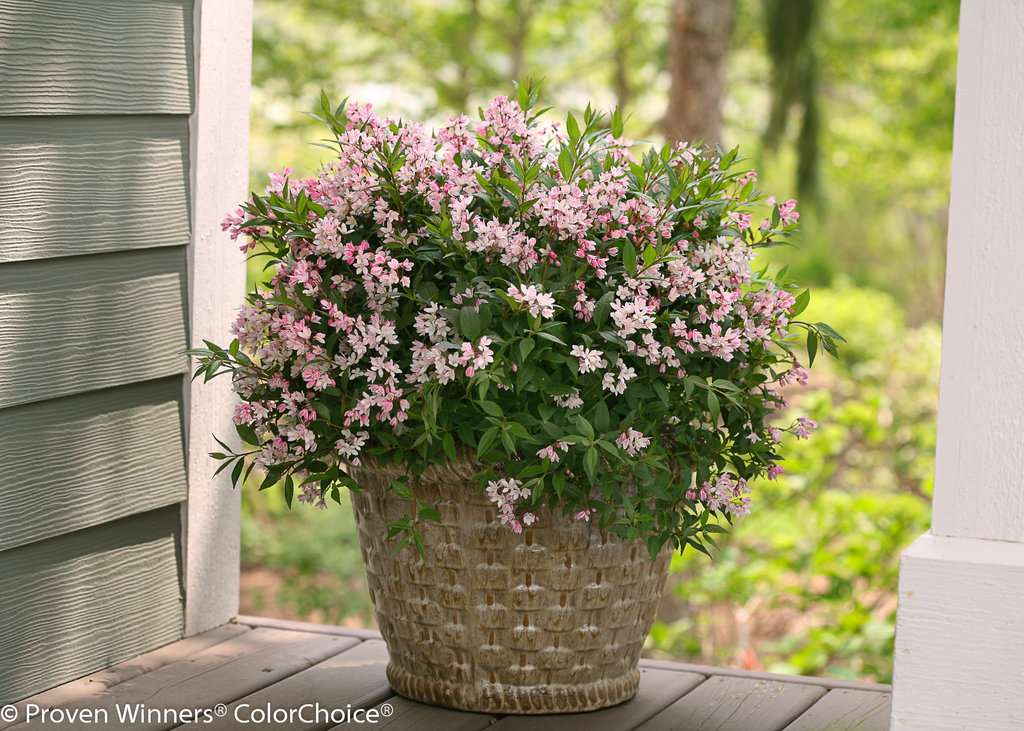
Deutzia ‘Yuki Cherry Blossom’ is well-suited for pot cultivation.
In a larger garden, it will look stunning planted in groups of three or five.
Plant larger deutzias like ‘Pride Of Rochester’ in a sheltered spot to enhance a flowering hedge; smaller semi-creeping varieties like Deutzia gracilis ‘Nikko’ or Deutzia x rosea will be perfect, planted en masse on a sunny bank, in a rockery, at the edge of a flower bed or path, or alone or mixed with other small ground-cover shrubs.
When to Plant?
The Deutzia sold in pots can be planted all year round, avoiding periods of frost and drought. Ideally, to encourage its establishment, it is best to plant in autumn, from September to November in warmer regions, preferably in spring in March-April in the rest of the country.
How to Plant?
In the Ground
For hedges, maintain a planting distance of 60 cm to 1 m between each plant.
- Soak the root ball in a bucket of water overnight before planting
- Loosen the soil well
- Dig a hole at least three times wider than the root ball and 50 cm deep
- Backfill with the extracted soil mixed with two buckets of compost, keeping the shrub upright and ensuring the collar is slightly below soil level
- Firm the soil, creating a basin at the base of the shrub
- Spread a 10 cm thick layer of organic pine bark mulch, especially in warmer regions
- Water thoroughly with two watering cans at planting
Growing Deutzia in a Pot
Choose dwarf varieties like Deutzia gracilis ‘Nikko’.
- Ensure a fresh, well-draining mix based on shrub compost mixed with well-decomposed compost
- Choose a large container of at least 30 litres (30 to 40 cm in diameter) and create a bed of gravel or clay balls at the bottom
- Mulch the base
- Water well during the growing season and whenever the soil is dry
Care
A well-established deutzia requires little care.
Deutzia is sensitive to dry soils in summer, it must never lack water. However, it can adapt to dry gardens with good mulching. Spread a good layer of organic mulch (bark or pine needles, leaf litter), renewed each year, to keep its roots cool during the summer heat.
Water regularly and moderately, every three to four days, especially during the first 2 or 3 summers.
For potted deutzia, water as soon as the soil becomes dry, as its needs are greater than in the ground.
Robust, deutzia is not prone to diseases.
Pruning deutzia: when and how to prune a deutzia?
The Deutzia requires light maintenance pruning every year or every two years, just after flowering. Pruning is useful for thinning the branches, restoring a lovely bushy shape, encouraging new branching, and promoting a new abundant and regular flowering.
- Prune the faded shoots by cutting them back by a third, above an outer bud
- Remove dead branches
- To rejuvenate an older plant, every 4 or 5 years, prune more severely down to the ground, removing old wood, dead, thin, or tangled stems to allow light to penetrate well into the heart of the branches; it will only flower again two years later
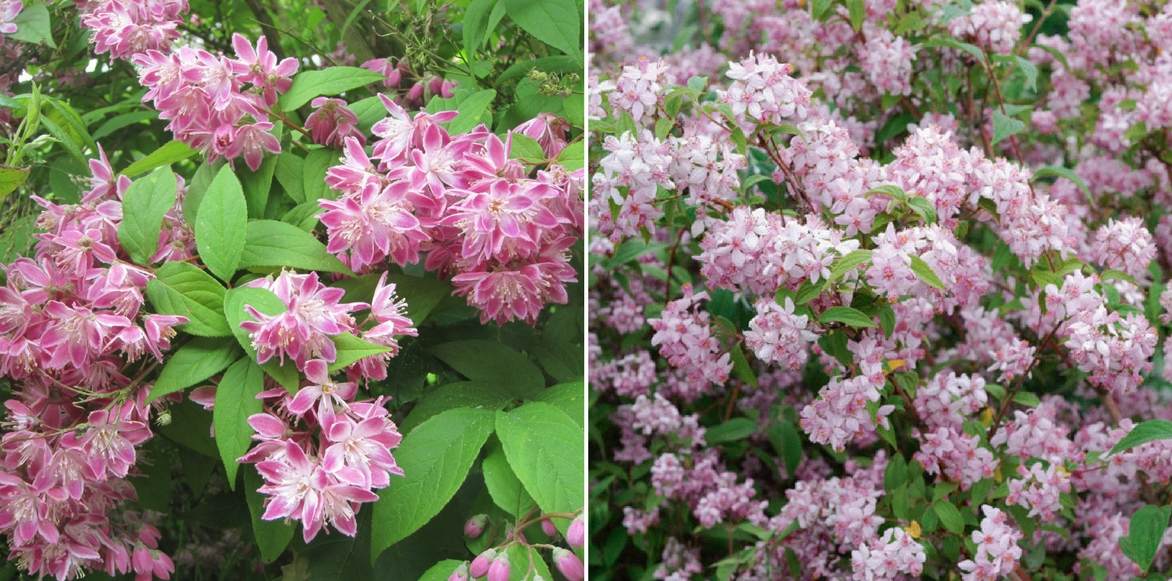
Deutzia ‘Strawberry Fields’ / Deutzia ‘Mont Rose’.
→ More tips on pruning Deutzia in our advice sheet.
Propagating Deutzia
Deutzia is quite easy to propagate by propagation by cuttings of the branches.
By semi-ripe cuttings
- After flowering, in August, take semi-woody or semi-ripe branches (which change from softwood to hardwood) measuring 10 to 20 cm, cutting 1 cm below a bud for the lower part
- Remove the lower leaves
- Plant them in a bucket to two-thirds of their length, leaving only the last bud above the surface in a light, well-draining substrate
- Regularly mist the cuttings with a spray bottle, rooting is quick
- Plant in the ground in autumn, if the root development is sufficient, or in the following spring.
By herbaceous cuttings
- In June, cut a stem just below a leaf or a bud
- Remove the leaves from the base
- Plant in pots or trays in a mixture of garden soil, compost, and river sand
- Regularly mist the cuttings and keep them sheltered until rooting
- Transplant them into the ground in autumn, when the root system is sufficiently developed
→ Learn more about the propagation by cuttings of Deutzia in our advice sheet!
Association Ideas
With its abundant flowering, Deutzia will always add a remarkable floral touch to the garden. It can be used both as a standalone plant, in a large pot, or in a country-style mass planting, in a sunny rockery, or at the edge of perennial plants. As it tolerates partial shade well, it is precious for bringing a refined and luminous touch to the darker corners of the garden.
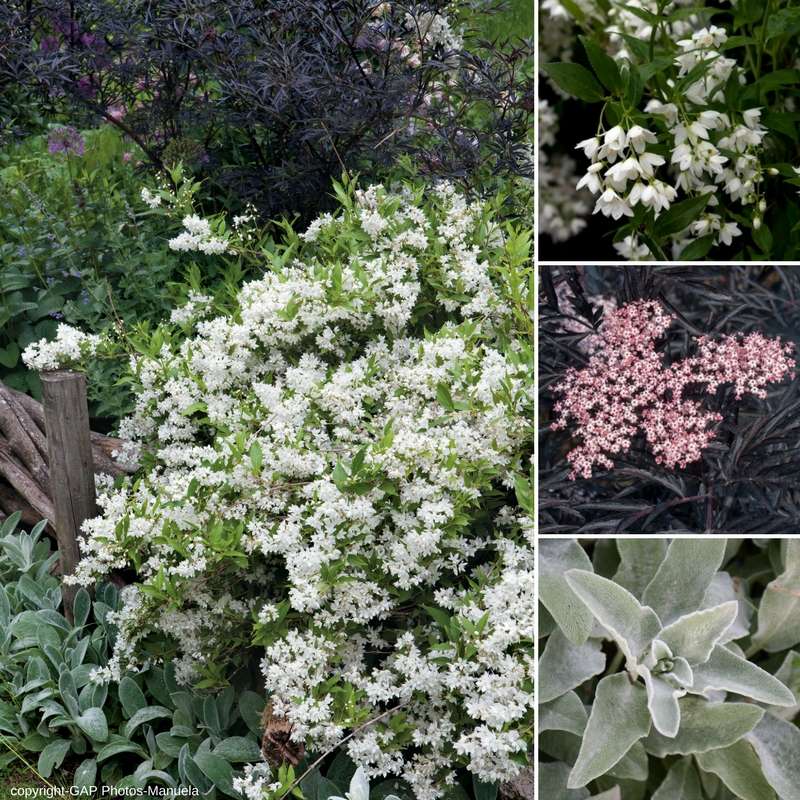
An example of a country-style association: Deutzia gracilis, Sambucus nigra ‘Black Lace’, Stachys byzantina.
It will integrate beautifully in pastel shades or to add contrast, in an English cottage garden, a vicarage garden, or simply a romantic and wild garden. Generally blooming during the rose season, at the end of spring and the beginning of summer, it is an exceptional subject in an all-white garden alongside old roses, ornamental tobaccos, and late white tulip bulbs, creating charming and romantic scenes.
In a free-standing hedge, it can be used in combination with other flowering shrubs such as Kolkwitzia, weigelias, Abelia, broom, or genets.
Alternate it with mock oranges or lilacs for a fully flowering hedge, or with evergreen shrubs for an interesting hedge all year round, such as barberries, cotoneasters, an eleagnus, an Osmanthus x burkwoodii, or a Mexican orange blossom ‘Apple Blossom’.

An example of a four-season hedge association: Osmanthus x burkwoodii, Berberis thunbergii, Eleagnus ‘Quicksilver’, Deutzia scabra ‘Plena’, Cotoneaster lacteus.
In a more contrasting version, it can be associated with the blue flowers of agapanthus, columbines, campanulas, the magenta pink of a valerian, or the carmine of a foxglove.
It pairs happily with almost all other colours, and the larger deutzias can support a late-flowering clematis.
Dwarf varieties (Deutzia Yuki Cherry Blossom) make excellent ground cover on a sunny slope, either alone or mixed with other small shrubs like Spiraea ‘Anthony Waterer’, dwarf weigelas, or ground cover roses like ‘The Fairy’ or even perennials like geraniums.
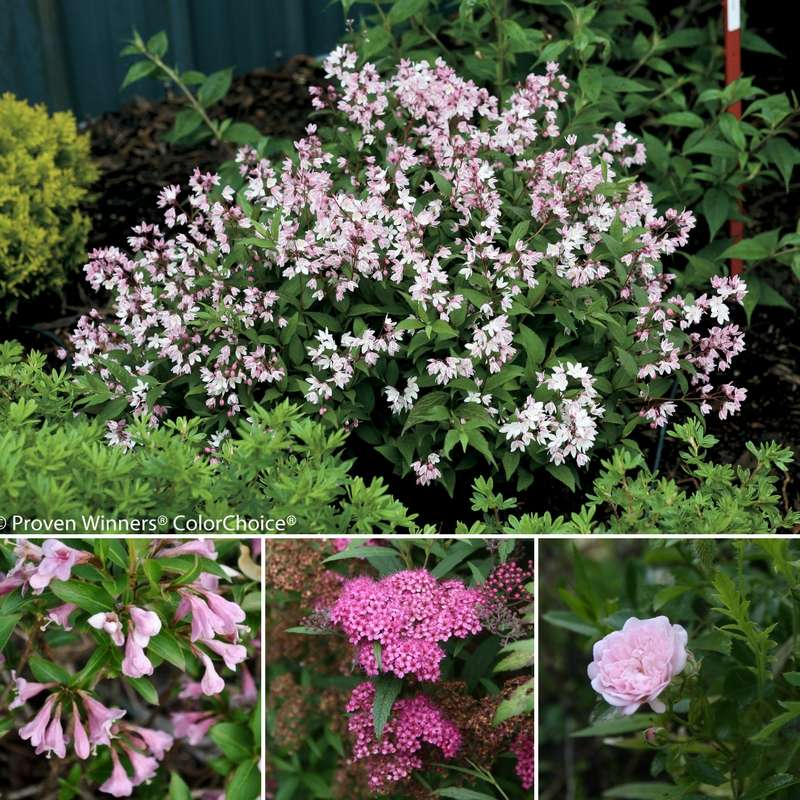
An example of an association on a slope: Deutzia ‘Yuki Cherry Blossom’, Weigela florida ‘Pink Poppet’, Spiraea japonica ‘Anthony Waterer’, Rosa ‘The Fairy’.
Useful resources
- The most beautiful spring-flowering bushes are with us!
- Advice sheet: Deutzias 5 ideas for association
- Advice sheet: Deutzia, when and how to prune it?
- Advice sheet: Growing a Deutzia in a pot
- Advice sheet: Choosing a Deutzia
- Our advice sheets: 7 Deutzias with pink flowers, 6 Deutzias with white flowers
- Discover our selection of 6 Deutzias perfect for a flowering hedge
- Subscribe!
- Contents
































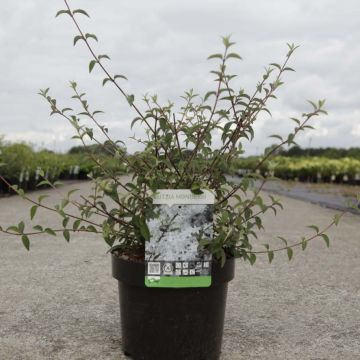


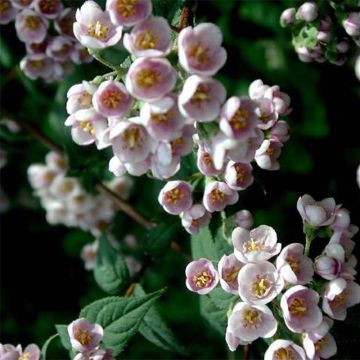
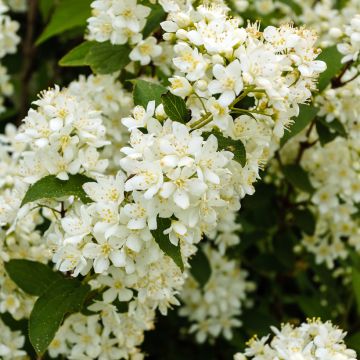

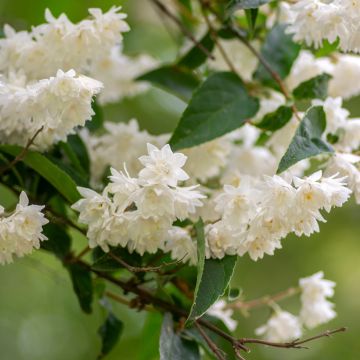
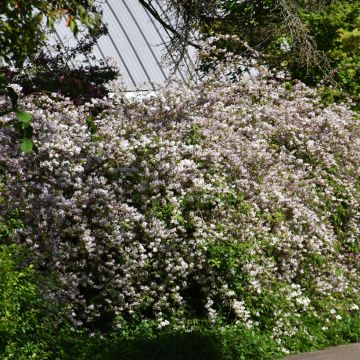
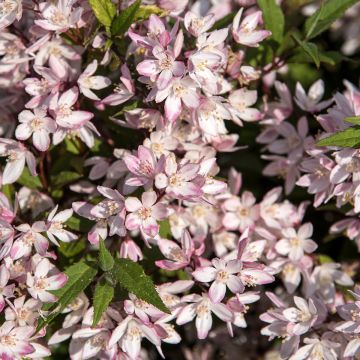
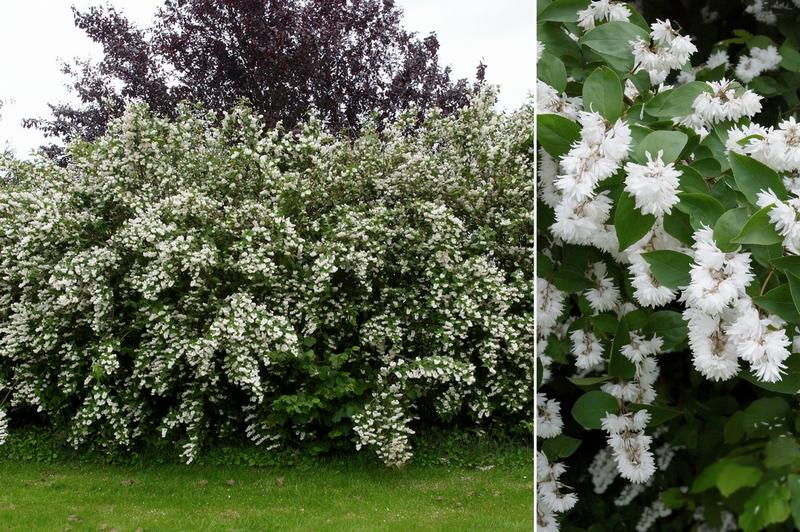
Comments